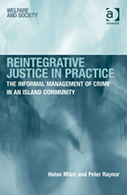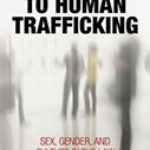Reintegrative Justice in Practice: The Informal Management of Crime in an Island Community

Authors: Helen Miles and Peter Raynor
Publisher: Farnham, Surrey, UK; Burlington, VT: Ashgate, 2014. 244p.
Reviewer: Kerry Clamp | July 2015
Miles and Raynor’s book Reintegrative Justice in Practice: The Informal Management of Crime in an Island Community is a well-written, informative and engaging overview of an ancient justice tradition operating in the channel island of Jersey. The Honorary and Parish Hall Enquiry System operates in all ‘parishes’ or ‘districts’ across the island and draws upon a number of volunteers responding to a range of offending behaviours. What makes this case study fascinating and indeed unique, as the authors point out, is that it is an example of ‘traditional locally-based participatory alternatives to formal court processing’ that still forms ‘an integral part of the current criminal justice system’ (p.4). The books novel contribution is that it responds to the limited scholarship about how the Parish Hall Enquiry System works and demonstrates the impact or effectiveness of the system in relation to the criminal justice process. Through their findings from direct observation and interviews, Miles and Raynor provide further insight into the practice of the Parish Hall Enquiry System by providing case examples of what actually happens during the process and what participants think of it.
This is an important contribution to the literature on informal justice practices; it is not often that one gets to read an in-depth case study of this nature. The discussion plots the history and origins of the Honorary System in Jersey (Chapter 2); the history, procedures and powers of the Parish Hall Enquiry (Chapter 4); and the findings of the structured observation of the system as well as its statistics (Chapter 5). Despite providing evidence that the Parish Hall Enquiry is an effective locally-based alternative to formal prosecution in the first three substantive chapters, Miles and Raynor report on two key challenges which threaten the ongoing success of the scheme. The first is a number of attempts to limit the reach of the Parish Hall Enquiry and to centralise the process. They outline evidence ‘which suggests that the traditional role of the Centenier’s Enquiry is being eroded by modern attempts at reform in order to achieve measurable outcomes,’ i.e. the application of penalties that can be considered ‘fair, ‘just’ and ‘consistent’ (p. 191). What is striking about this case study is that it is a model which other countries in the Western world, particularly in neighbouring locations such as England and Wales, are trying to emulate. Governments are actively seeking ways to devolve power down to communities, albeit with a reduced scope in terms of the seriousness of offences that would be eligible, in order to combat offending affecting the quality of life in communities. It is a shame that a process which is shown to be effective in providing locally informed solutions to locally grown problems, could potentially be undermined and transformed to one where generic responses are given to generic forms of behaviour.
The second, and perhaps most important in terms of threats to the Parish Hall Enquiry System, is the recruitment and retention of honorary officers. This issue is not specific to Parish Hall Enquiries, but has been reported in other community-based schemes including community justice panels (see Clamp 2014); peace making circles (see Bazemore and Schiff 2004), and referral orders (see Crawford and Newburn 2003). Given the prominence of this issue for other models that are similar to Parish Hall Enquiries, Miles and Raynor perhaps missed an opportunity to offer suggestions as to how this issue might be addressed and understood in the broader changes that are taking place in neo-liberal states. This would have been a welcome contribution to the international literature on the broader topic of community-based approaches.
In the final three substantive chapters, Miles and Raynor seek to situate their case study into the broader literature on ‘what works’ in communicating with and supervising offenders (Chapter 6), community justice (Chapter 7) and restorative justice (Chapter 8). However, the extent to which they were successful in achieving this objective is perhaps not as evident as with earlier chapters. Readers may find the style in which the information is presented detracts from the narrative that they created in the first half of the book. For example, Part 1 in Chapter 6 seeks to define and describe the features of traditional justice. The authors certainly do this, but only briefly and without comprehensively exploring their complexities or any literature which might challenge/contradict the sources that they used. A more integrated discussion may have been more useful than presenting it in a glossary style with one or two sentences on other indigenous justice practices. Alternatively, Miles and Raynor might have discussed other island communities and their justice practices, rather than ‘indigenous’ justice more broadly. In this respect, a stronger narrative linking the case study to the literature on community justice would have made for more enlightening reading.
Given the breadth of literature which Miles and Raynor are traversing, they were bound to miss some of the nuances and intricacies contained within these capacious research topics. This was most noticeable in relation to their writings on restorative justice. For example, they assert that an ‘[a]nalysis of the central themes and critical issues surrounding restorative justice is often presented using a dichotomous approach (Zehr 1990; Graef 2001)’ referring, in particular, to debates that have been had in relation to restorative justice and retributive justice (p.134). However, in a later publication, Zehr (2002) conceded that retribution has some restorative qualities and has thus moved away from this strict dichotomy which the authors draw attention to. In fact, many restorative scholars have labelled the dichotomy that Miles and Raynor refer to as being ‘false’ and see very little value in this debate currently.
The authors also appear to misinterpret particular elements of the restorative justice literature. This is evident in their discussion of the linking of restorative justice and indigenous justice practices. They suggest that ‘Daly seems to deny the compatibility of indigenous and contemporary justice and thus suggests that effective community-based restorative justice is impossible’ (p.135). However, Daly is not suggesting that contemporary indigenous justice practices and restorative justice have no similarities, but rather that people elevate the status of restorative justice by linking it back to some rosy picture of how justice used to be done. Such an approach is used to add further legitimacy to restorative practice in an effort to sell it to policy-makers. In Daly’s (2002: 62) words: ‘if it can be established that the first form of human justice was restorative justice then advocates can claim legitimacy for contemporary restorative justice alternatives to state-sponsored retributive justice’. The use of Maxwell and Morris’s publications on the New Zealand family group conferencing system within the book is a case in point; there are a number of publications which are critical of the claims of the ‘indigenousness’ of this system (see, for example Tauri 2014).
While the range of literature is good and the key sources are referred to, a crucial piece of literature was missed which, perhaps, would have altered some of the assertions and the structure of the book. Crawford and Clear (2003) offer an important contribution on what community is and how community justice and restorative justice differ. Drawing on this literature could have lent further support to some of their assertions, but perhaps most importantly, would have clarified for them that the Parish Hall Enquiry System is a form of community justice, rather than restorative justice. As Crawford and Clear (2003: 216) explain:
While restorative justice is about cases, community justice is about places. A restorative justice program ‘works’ when key constituents experience a restorative process and end up feeling restored by it. Community justice programs ‘work’ when the quality of life in a given place improves.
It is clear throughout the book that the authors are talking about a community justice program. They acknowledge that the process and outcomes are more focused on the community than individuals per se. The victim, for the most part, remains a silent or even missing actor in the process which means at best the Parish Hall Enquiry System could only ever be considered, at best, partially restorative. The fact-finding remit of the process and the central place of the Centenier in determining the scope and outcomes of the Enquiry also means that it veers far from what many proponents would think is restorative. Had the authors focused their discussion within the community justice literature, I believe it would have made a much more solid contribution to that literature.
Nevertheless, I would recommend the book for those with an interest in community-based justice practices. While the structure, outcomes and issues of the Parish Hall Enquiry System will have a familiar feel for those with a broad knowledge of community justice schemes, the nuances, history and scope of the approach is certainly novel.
Dr Kerry Clamp, Lecturer in Criminology and Editor of the Newsletter for the European Forum for Restorative Justice, University of Western Sydney
References
Bazemore, G., and Schiff, M. (2004) Juvenile Justice Reform and Restorative Justice: Building
Theory and Policy from Practice. Portland, OR: Willan Publishing.Clamp, K (2014) ‘A “Local” Response to Community Problems? A Critique of Community Justice
Panels’, British Journal of Community Justice, 12(2): 21-34.Crawford, A., and Clear, T. (2003) ‘Community Justice: Transforming Communities through
Restorative Justice’, in E. McLaughlin, R. Fergusson, G. Hughes and L. Westmarland, (eds), Restorative Justice: Critical Issues. London: Sage.Crawford, A., and Newburn, T. (2003) Youth Offending and Restorative Justice: Implementing
Reform in Youth Justice. Devon, UK: Willan Publishing.Daly, K. (2002) ‘Restorative Justice: The Real Story’, Punishment & Society, 4(1): 55-79.
Graef, R. (2001) Why Restorative Justice?London: Calouste Gulbenkian.
Tauri, J. (2014) ‘An indigenous commentary on the globalisation of restorative justice’, British
Journal of Community Justice, 12(2): 35-55.Zehr, H. (1990) Changing Lenses. Scottdale, PA: Herald Press.
Zehr, H. (2002) The Little Book of Restorative Justice. Intercourse, PA: Good Books.


